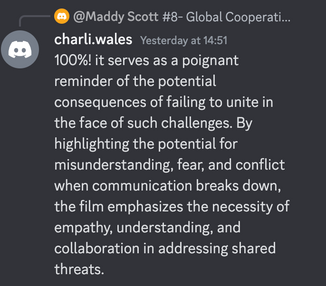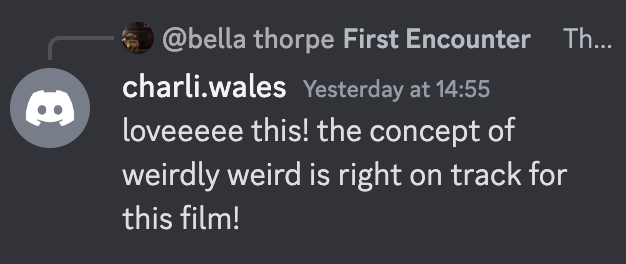Exploring the Intersection of Technology and Humanity through Cinema. *SPOIL DISCLAIMER*
- crosewales15
- May 31, 2024
- 4 min read
Updated: May 31, 2024
In our ever-evolving world, cinema serves as a powerful tool to examine the past, present, and potential futures shaped by technology. Drawing inspiration from Einstein's words on predictability, we embark on a journey of cinematic exploration, this time through the lenses of three iconic films: "The Matrix" (1999), "Arrival" (2016), and "Ready Player One" (2018). Each of these movies offers a unique perspective on the interplay between humanity and technology, delving into themes of artificial intelligence, the evolution of society, and the possibilities that lie ahead.
The Matrix
"The Matrix" presents a dystopian vision where humanity is enslaved by machines, living in a simulated reality while their bodies are used as energy sources. This film challenges our perception of reality and raises profound questions about the nature of existence and the potential consequences of unchecked technological advancement. Through the character of Neo, "The Matrix" explores themes of liberation, self-discovery, and the power of individual agency in the face of overwhelming technological control.
Anne Balsamo's article on the technological embodiment provides a lens through which to analyze the film's themes. In The Matrix, humans rely on machines for survival while their minds inhabit virtual reality, while artificial intelligence depends on humans for energy. Balsamo outlines four forms of technological embodiment: the laboring body, This term refers to the female material and maternal body (227). The marked body, Balsamo describes this concept as the natural body being literally transformed into a sign of culture, and this sign becoming a commodity for sale (225). The repressed body, describing this concept as the interface between the human body and virtual reality applications (228-229) and the disappearing body, Balsamo describes this concept as the replacement of human body parts with bio-engineered components. The Matrix vividly portrays these concepts, illustrating how the human body is entwined with technology and virtual experiences, blurring the boundaries between physical and digital realms. As technology progresses, the film's themes resonate even more deeply, prompting reflection on the nature of humanity and the consequences of our technological creations.
Arrival
"Arrival" takes a more introspective approach to the intersection of technology and humanity, focusing on the arrival of extraterrestrial beings and the efforts to communicate with them. As humanity grapples with the profound implications of this encounter, the film examines the role of language, communication, and empathy in bridging the divide between different species. At its core, "Arrival" is a meditation on the ways in which technology can both unite and divide us, highlighting the importance of understanding and compassion in an increasingly interconnected world.
"Arrival" stands out as a unique and unexpected gem in the science fiction genre. Touted as one of the best sci-fi films of the 21st century, it distinguishes itself by focusing on communication and human connection rather than relying on typical sci-fi elements like dystopian futures or high-tech action sequences. The film explores the Sapir-Whorf hypothesis, which suggests that the structure of a language affects its speakers' worldview and cognition. The film also innovatively handles time shifts. It motivates its non-linear structure through its story and makes it clear to the audience, tackling all three essential tasks effectively.
Ready Player One
The year is 2045, and the world is in ruins. Conditions have deteriorated to the point where most people prefer to spend their time immersed in a massive virtual reality game called the OASIS. One of the critical questions the film raises is whether we should root for the real world's destruction, given the allure and apparent superiority of the virtual OASIS. While the OASIS offers endless possibilities and an escape from reality, the film ultimately suggests that it is essential to face and improve the real world. The resolution of the story emphasizes that despite its flaws, the real world is worth fighting for and preserving.
It might sound overly pedantic, but I couldn't stop wondering about the state of the world outside the OASIS. Are people starving or living in fear for their lives? Can everyone afford the headsets, or are there people trapped in the dystopian ruins without any means of escape? What kind of turmoil has driven society into this dystopian condition, and why does no one believe it can be repaired? Isn't it horrifying that they've completely abandoned the real world?
Conclusion
In each of these films, technology serves as both a tool for advancement and a potential threat to humanity. Whether it be the simulated reality of "The Matrix," the linguistic challenges of "Arrival," or the immersive virtual world of "Ready Player One," these movies invite us to contemplate the ways in which technology shapes our lives and the choices we make as individuals and as a society. As we navigate an increasingly complex technological landscape, these cinematic visions offer valuable insights into the challenges and opportunities that lie ahead.
REFERENCES
This blog was assisted by ChatGPT.
Balsamo, Anne. “Forms of Technological Embodiment: Reading the Body in Contemporary Culture”. Body & Society.1995: Vol.1 (3-4):215-237. 1995.
Dalimu1, S., Ansor, P. and Azi3 (n.d.). THE PORTRAYAL AND THE EFFECTS OF HYPERREALITY IN READY PLAYER ONE MOVIE BY STEVEN SPIELBERG (THE APPLICATION OF JEAN BAUDRILLARD’S THEORY). [online] Available at: https://core.ac.uk/download/pdf/335134387.pdf [Accessed 4 Apr. 2023].
Lucy, J.A. (2015). Sapir-Whorf Hypothesis - an overview | ScienceDirect Topics. [online] Sciencedirect.com. Available at: https://www.sciencedirect.com/topics/psychology/sapir-whorf-hypothesis.
Observations on film art. (n.d.). ARRIVAL: When is Now? [online] Available at: https://www.davidbordwell.net/blog/2016/11/23/arrival-when-is-now/.
Serrano, S. (2019). ‘The Matrix’ Changed Everything, but the Little Details Made It Even Greater. [online] The Ringer. Available at: https://www.theringer.com/movies/2019/3/28/18285249/the-matrix-1999-20th-anniversary-keanu-reeves-wachowskis-brothers.













































Comments